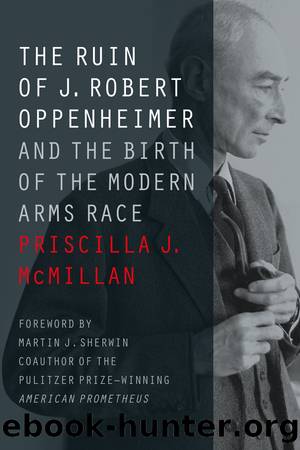The Ruin of J. Robert Oppenheimer by Priscilla J. McMillan

Author:Priscilla J. McMillan
Language: eng
Format: epub
Publisher: Johns Hopkins University Press
CHAPTER EIGHTEEN
The Hearing Begins
ONE MORNING IN JANUARY, a Scottish-born reporter for a famous newspaper was looking for a seat on an airplane out of Washington. He found one next to a rumpled-looking blue-eyed man who did not seem happy to see him. Well aware of the manâs identity, the reporter engaged Robert Oppenheimer in chitchat about Eisenhowerâs first year in office. Although he steered away from topics he thought might be troublesome, the man noticed that his companion nonetheless seemed nervous and under strain.1
That was all James Reston needed. On his return to the capital, he started asking around. What he found was dynamite, and before long Lloyd Garrison confirmed Restonâs scoop: the government had confronted the scientist with charges, suspended his clearance, and scheduled a hearing. Garrison asked Reston, Washington bureau chief of the New York Times, not to publish until Oppenheimer had had time to complete his response, so that charges and rebuttal could appear simultaneously. The Timesâs publisher, Arthur Hays Sulzberger, agreed, and for six weeks the paper held the story amid worries that Senator Joseph McCarthy or a Times competitor might break the news at any moment. Finally, only days before the Oppenheimer hearing was to begin, McCarthy charged on nationwide TV that Communist sympathizers in the government had caused a âdeliberate eighteen-month delayâ in the hydrogen bomb, a figure he had apparently lifted from Charles Murphyâs anonymous article in Fortune the year before. Eisenhower replied that he knew of no such delay.
Anxious to trump McCarthy, Lewis Strauss and presidential press secretary James Hagerty concocted a strategy to trigger publication, and on April 13, the second day of the hearing, Restonâs story appeared on page 1 of the New York Times. Gordon Gray, chairman of the hearing board, was outraged. Garrison had promised that he would try to restrain publication, and Gray thought Garrison had double-crossed him. Since no one at the AEC or the White House informed him that it was they who had double-crossed him, Gray scolded Garrison as the hearing opened and in the weeks that followed reprimanded him repeatedly for havingâso Gray thoughtâbroken his promise. The duplicity of this maneuver, whereby high officials of the AEC and the White House deceived their own handpicked chairman, was typical of what was to happen in the weeks ahead.2
Oppenheimerâs friend Joseph Volpe later said the proceeding was âlike a hearing on your wife after youâve been married twenty years.â In his dozen years of government service Oppenheimer had been through four high-level reviews, among them the 1947 review in which Hoover and Strauss had agreed to clearance.3 This new proceeding was unlike any of the others in that it resembled a criminal trial, with the burden of proof on one side only: the defense. It was held in a dilapidated government building with only lawyers, witnesses, and a handful of officials present. The location was not announced, reporters were not permittedâindeed, they were not formally told that it was happeningâand each witness was informed as
Download
This site does not store any files on its server. We only index and link to content provided by other sites. Please contact the content providers to delete copyright contents if any and email us, we'll remove relevant links or contents immediately.
De Catalaanse brief by Robert Goddard(323)
A Piece of Cake by Sarah Swatridge(256)
Churchill's Spearhead by John Greenacre(231)
Nonlinear Dynamics and Chaos with Student Solutions Manual by Steven H. Strogatz(222)
The Ruin of J. Robert Oppenheimer by Priscilla J. McMillan(199)
Popular Culture and Political Identity in the Arab Gulf States by Alanoud Alsharekh Robert Springborg(175)
Flowering of the Cumberland by Harriette Simpson Arnow(175)
thing bounces back europe by Unknown(167)
Allied Bombing Raids by Philip Kaplan(165)
A Japanese View of Nature by Kinji Imanishi Pamela J. Asquith(161)
Guild and State by Antony Black(155)
Comet Madness by Richard J. Goodrich(153)
RAF at the Crossroads by Greg Baughen(144)
History Without A Subject by David Ashley(138)
The Seventies Now: Culture As Surveillance by Stephen Paul Miller(137)
A History of Greek and Roman Philosophy by John Hackney(136)
A History of Science in Society by Ede Andrew;Cormack Lesley B.;(132)
Shocking Bodies by Iwan Rhys Morus(130)
Air Battle for Burma by Evans Bryn;(129)
